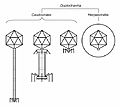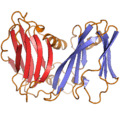DNA virus facts for kids
Imagine tiny invaders, so small you can't see them, called viruses. Some of these viruses are special because they use something called DNA as their main instruction book, or genome. These are known as DNA viruses. Think of DNA as the blueprint that tells the virus how to make more copies of itself. A common example of a DNA virus is the Herpes simplex virus. Other viruses use a different kind of instruction book called RNA, and those are called RNA viruses.
Contents
What are DNA Viruses?
DNA viruses are a group of viruses that store their genetic information using DNA. This DNA acts like a detailed instruction manual. It tells the virus how to build new virus particles once it gets inside a living cell.
DNA: The Virus Blueprint
Every living thing, including you, has DNA. It carries all the instructions for life. For DNA viruses, their DNA is their entire plan. It contains all the steps needed to take over a cell and make more viruses. This is different from RNA viruses, which use RNA as their main genetic material.
How DNA Viruses Work
When a DNA virus infects a cell, it injects its DNA into the cell. The cell's machinery then reads the viral DNA. It follows these instructions to make new parts of the virus. Soon, many new virus copies are made, and they can then go on to infect other cells.
Common DNA Viruses
There are many types of DNA viruses. They can affect humans, animals, and even plants. One well-known example is the Herpes simplex virus. This virus can cause cold sores. Another example is the canine parvovirus, which affects dogs.
Herpes Simplex Virus
The Herpes simplex virus is a common DNA virus. It often causes small, painful blisters. These blisters can appear around the mouth or on other parts of the body. Once you have the virus, it stays in your body. It can become active again later, especially when you are stressed or sick.
Canine Parvovirus
The canine parvovirus is a serious DNA virus that affects dogs. It causes a very contagious disease. This virus attacks the intestines and white blood cells. It can make puppies very sick. Vaccinations help protect dogs from this virus.
Images for kids
See also
 In Spanish: Virus ADN para niños
In Spanish: Virus ADN para niños





